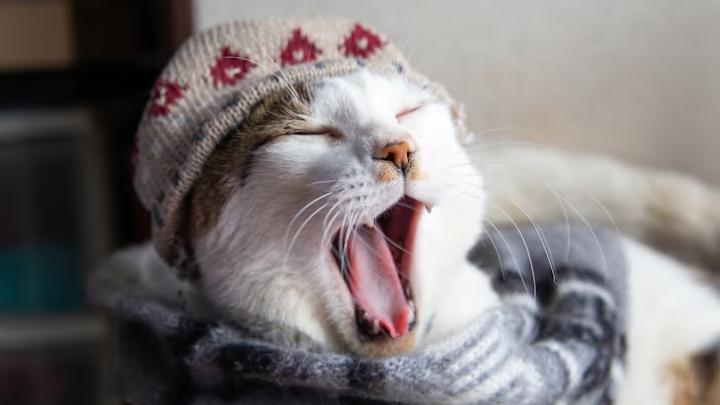Researchers at the University of Montreal faced a problem when studying chronic pain in cats. Their furry subjects tended to shake off or damage the wired electrodes of brain scanners meant to detect pain, leading to less accurate results. Now, as Futurism reports, they’ve found a solution to the issue in an unlikely place: feline fashion.
Once they’re outfitted with crocheted hats, cats become comfortable (and adorable) test subjects. The new method is laid out in a study published in the Journal of Neuroscience Methods. Without the bonnets, veterinary researchers were forced to sedate the cats and inject intradermal electrodes—which, in addition to being invasive, can also interfere with pain perception. Clearly this is not ideal for studies examining chronic pain.
Scientists were looking for an alternative way to conduct their research when they came across Catventurous Crotchet’s YouTube tutorial for cat hats. They recruited a grad student to crochet the caps, hoping they would provide the missing element to their study.
The team placed the crocheted beanies on 11 cats with osteoarthritis—a condition in which cartilage around the joints steadily wears down, causing pain, swelling, and decreased mobility. After assessing the felines’ pain and stress through surface electrodes, the researchers attempted to ease their discomfort by introducing them to soothing stimuli, including colored lights and the scent of grapefruits.
More research is needed to determine if such stimuli actually reduces pain in cats, but thanks to the cozy accessories, that research is now easier to conduct. The latest study marked the first time that electrodes were used to study brain activity in awake cats. In the report’s conclusion, the authors state that the research “opens new avenues for investigating feline chronic pain and its potential modulation through sensory interventions.”
While osteoarthritis is common in cats and dogs, it’s less diagnosed in felines. Cats can hide and tolerate joint pain more easily due to their size and agility; therefore, it’s difficult for people—even experienced veterinarians—to notice their suffering. Felines typically don’t like to be touched during examinations. For that reason, it may be difficult for vets to determine if a cat is pulling away because they are in pain or simply don’t want to be handled.
In general, there’s a massive disparity between cats and dogs in scientific research—but with innovations like crocheted cat beanies, that may change.
Read More About Cats:
